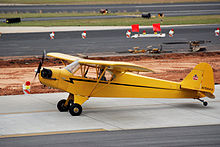 | This is a user sandbox of Apn13. You can use it for testing or practicing edits. This is not the sandbox where you should draft your assigned article for a dashboard.wikiedu.org course. To find the right sandbox for your assignment, visit your Dashboard course page and follow the Sandbox Draft link for your assigned article in the My Articles section. |


| Chrome Yellow | |
|---|---|
| Hex triplet | #FFA700 |
| sRGBB (r, g, b) | (255, 167, 0) |
| HSV (h, s, v) | (39°, 100%, 100%) |
| CIELChuv (L, C, h) | (75, 105, 46°) |
| Source | ColorHexa[1] |
| ISCC–NBS descriptor | Strong orange yellow |
| B: Normalized to [0–255] (byte) | |
Chrome yellow is a yellow pigment in paints using monoclinic lead(II) chromate (PbCrO4). It occurs naturally as the mineral crocoite but the mineral ore itself was never used as a pigment for paint. After the French chemist Louis Vauquelin discovered the new element chromium in 1797 lead chromate was synthesized in the laboratory and used as a pigment beginning in the second decade of the nineteenth century.[2]
Chrome yellow had been commonly made by mixing solutions of lead nitrate and potassium chromate and filtering off the lead chromate precipitate.
The pigment tends to react with hydrogen sulfide and darken on exposure to air over time, forming lead sulfide,[3] and it contains the toxic heavy metal lead plus the toxic, carcinogenic chromate. For these reasons, it was replaced by another pigment, cadmium yellow (mixed with enough cadmium orange to produce a color equivalent to chrome yellow).[4] Darkening may also occur from reduction by sulfur dioxide. Good quality pigments have been coated to inhibit contact with gases that can change their color.[5] Cadmium pigments in turn are increasingly replaced with organic pigments such as arylides (Pigment Yellow 65) and isoindoles (PY 110).
Structure edit
Production edit
History edit
After working with the natural mineral crocoite, Nicolas Louis Vauqelin was the first to encourage artists to use chrome yellow as a pigment in 1804.[7] The first recorded use of chrome yellow as a color name in English was in 1818.[8] By 1888, avant-garde artists like Vincent Van Gogh were using chrome yellow with the other two primary colors.[7]
The Piper J-3 Cub aircraft had chrome yellow as its standard overall color, usually called "Cub Yellow" or "Lock Haven Yellow" in aviation circles, from the Piper factory that existed in Lock Haven, Pennsylvania, where it was made in the 1930s and during World War II.
Chrome yellow is a ‘Hero colour’ of the Holden HQ range.
See also edit
References edit
- ^ "Chrome yellow / #ffa700 hex color". ColorHexa. Retrieved 2022-12-20.
- ^ Kühn, H. and Curran, M., Chrome Yellow and Other Chromate Pigments, in Artists’ Pigments. A Handbook of Their History and Characteristics, Vol. 1, L. Feller, Ed., Cambridge University Press, London 1986, p. 187 – 204, pp 188-190
- ^ Pichon, A. Pigment degradation: Chrome yellow’s darker side. Nature Chemistry, 5(11), 2013, 897–897. doi:10.1038/nchem.1789
- ^ Gettens, Rutherford John; Stout, George Leslie (1966). Painting Materials: A Short Encyclopaedia. Courier Dover Publications. p. 106. ISBN 978-0-486-21597-6.
- ^ Entry on Bleichromat-Pigmente. at: Römpp Online. Georg Thieme Verlag, retrieved 22. Juli 2018.
- ^ Worobec, Mary Devine; Hogue, Cheryl (1992). Toxic Substances Controls Guide: Federal Regulation of Chemicals in the Environment. BNA Books. p. 13. ISBN 978-0-87179-752-0.
- ^ a b Clair, Kassia St. (2017). The Secret Lives of Color. New York, New York: Penguin Books. pp. 78–79. ISBN 9780143131144.
- ^ Maerz and Paul A Dictionary of Color New York:1930 McGraw-Hill Page 192; Color Sample of Chrome Yellow: Page 43 Plate 10 Color Sample L4
Further reading edit
- Kühn, H. and Curran, M., Chrome Yellow and Other Chromate Pigments, in Artists’ Pigments. A Handbook of Their History and Characteristics, Vol. 1, L. Feller, Ed., Cambridge University Press, London 1986
External links edit
- Chrome yellow, Colourlex
- Pichon, A. Pigment degradation: Chrome yellow’s darker side. Nature Chemistry, 5(11), 2013, 897–897. doi:10.1038/nchem.1789